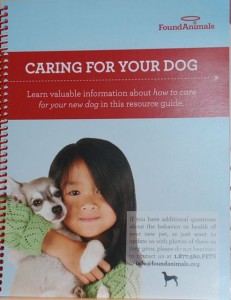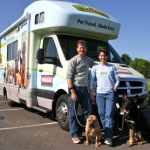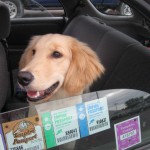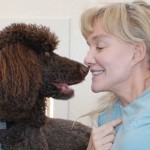If I had to choose the single most important cue I want my Sadie girl to answer to on a dime no matter what—
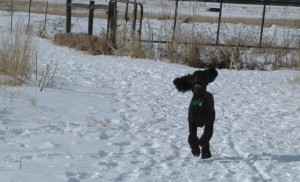
Here comes Sadie!
no matter how far away she is from me or seductive the distractions—it’s ‘come.’ Actually our recall word isn’t ‘come’ it’s Sa-die-Sa-die which I call out in a high pitched staccato voice that resonates at the roof of my mouth, an approach I learned from watching a Patricia McConnell DVD years ago when Sadie was a puppy.
Sa-die-Sa-die! is our extra special recall so I don’t use it willy-nilly. When I burst forth with Sa-die-Sa-die! I want an automatic, non-thinking response to a stimulus. The stimulus? My calling Sa-die-Sa-die! The response? An instant, snappy head-turn, followed by her running to me as fast as her four furry legs will carry her. This is the recall I protect and keep polished as if it were a priceless gem—because it is.
There are other words I call out to Sadie in a normal up-beat tone of voice that also mean ‘come’: Sades, let’s go, funky-monkey, punky-poodle, pookie-dookie, stuff like that. Usually she responds immediately, but if she wants to get in one last sniff before bounding or merely trotting to me, I’m okay with that.
Before I share with you Sadie’s and my 13 tips for training and retaining a great recall using reward-based training methods, let’s ponder a question Trish McMillan Loehr posed yesterday during a conversation I started on Facebook: “In general, animals will work either to get the carrot or to avoid the stick. Which do you think creates the better relationship?”
If you use a shock collar to train a recall, even in the best-case scenario, you are using the stick approach. Let’s say your recall word is ‘come!” Here’s how you would begin. Put your dog on a leash. Let the dog walk away from you. Call out ‘come.’ Then press the button on the remote control so the collar sends an electric current into your dog’s neck. Depending on the setting on the remote control, the current could be mildly discomforting or outright painful. As soon as the dog turns toward you either by your pulling on the leash or on her own volition, you stop sending the electric current. The dog learns to ‘come’ because it’s too painful not to. Your dog comes to you to ‘avoid the stick.’
I prefer the ‘carrot’ approach not only because I could not deliberately inflict physical pain (or discomfort) on Sadie in order to train her, but because I want a great relationship with her. I want Sadie to feel confident venturing into the world and to think I am the coolest, ‘funnest,’ most awesome thing happening in her environment.
So how did we train Sadie’s recall, and how are we keeping it sharp? First of all we’ve had great teachers in Nana and Gigi. From their work with us Sadie and I have distilled the following:
13 Tips for Training and Retaining a Great Recall
1. Do decide what your ‘recall’ word is. If the word looses its salience to your dog, let’s call him Spot, if he no longer comes when you call him for whatever reason, select a new word. Start training Spot all over again using the new word.
2. Do positively reinforce snappy head turns when you call out the recall word. I like using a clicker to mark the head turn and then reinforcing that behavior with small pieces of special, scrumptious food Sadie gets only for recall work. You don’t have to use food as long you do something Spot is totally crazy about, and will therefore have the effect of reinforcing the head turn. Keep that activity special. Spot only gets to do it when working on recalls.
3. Do practice in places with no distractions at first. Gradually increase distractions and distance, but not at the same time at first. Work on one and then the other. Slowly combine the two after each is masted separately.
4. Do run away. As you very gradually increase the distance between you and Spot, call out the recall word and mark the snappy head turn with a clicker or “Yes!” and then run away from Spot. Most likely Spot will chase after you. When Spot catches up with you reinforce his coming to you with his special food and/or special activity—have a party!!!
5. Do play ‘catch and release’. Call out your recall word, run away, have a party when Spot catches up to you and then “release” Spot to go play again. This teaches Spot that ‘coming’ is really cool. He gets to have goodies and to go back to playing. We don’t want Spot to associate ‘coming’ with the ‘fun ending’.
6. Do practice recalls in fenced areas or with Spot on a long leash until Spot’s recall is reliable. Safety first.
7. Do not call Spot to you to deliver bad news, for example nail trimming, or putting on leash to leave the park or trail. You go to Spot instead.
8. Do practice recalls in lots of different places—the house, your yard, puppy kindergarten, the dog park, during a walk, at the hardware store, etc.
9. Do practice restrained recalls. Another person holds onto Spot while you run in the opposite direction. This builds up Spot’s excitement to come to you when you call him.
10. Do a practice a recall or two every time you visit a new place or an old place you haven’t been to for awhile. I’ve learned it’s important for Sadie and me to refresh our recall routine in new contexts. Dogs don’t generalize very well. Just because recall rules apply on Sadie’s favorite trail doesn’t mean she’ll know they apply at the park unless we do a practice round or two.
11. Do use an up-beat voice for recalls. Think about it. Would you want to go to someone who was calling you in a gruff and angry voice?
12. Do not call Spot when you know he’s not likely come anyway. This is easier said than done, especially if you, like me, are freaking out because Spot is running after another dog or whatever. I don’t want Sadie to ‘practice’ ignoring me when I call her. If she does, then we move onto tip #13.
13. Do not ignore ‘not coming’. If I call Sadie and she doesn’t come, even though it’s a rare occurrence, I don’t let it pass. I use negative punishment. In other words, I take away something she wants, namely being free to sniff around. play, and chase, because I want to decrease the likelihood of her ‘not coming’ again. Typically I do something like this. I become totally quiet and unemotional. When I catch up to her, I attach her leash. I hold the leash short enough for her to walk next to me without choking, but not long enough for her to explore. I anchor my hands at my navel so the tension on the leash is steady. Silently we walk out of the park or off the trail. I put Sadie into the car and drive home.
I dislike tip #13 most of all. So does Sadie, I’m sure. I don’t give Sadie much slack on recalls. If I call and she doesn’t come, #13 goes into effect. If we are miles from the trailhead, I’ll walk with her in silence on a short leash for about a mile. Then I ask her to sit and stay. Then I release her. A minute later I call her. If she comes, and she never hasn’t, then we’re good to go. Otherwise, I’d leash her up again and keep her leashed until we got to the car.
There were times early on when I wondered what all of our intense recall work was truly reaping. We’ll, I’ll tell you a story. Please pardon my moment of bragging, but my girl was awesome.
It was early on a Saturday morning. We were on the Sanitas Valley Trail. That’s a picture of it in the header of ths page. I was talking with a friend when suddenly I looked up and saw a herd of deer crossing the trail, a rare event. Sadie was in front of me. She held her body erect and perfectly still staring at the deer. I recognized it as her pre-chase stance. “Sa-die-Sa-die!” My voice pierced the air. Sadie’s head snapped back in my direction. I ran away from her and the deer tossing out a high-pitched continuous yodel-like sound, imagining my voice was a line with which I could reel Sadie in. She came barreling towards me, bouncing in the air as she arrived next to me. Jackpot! I gave her ALL of the best stuff I had. We partied and, I’m not kidding, people applauded!
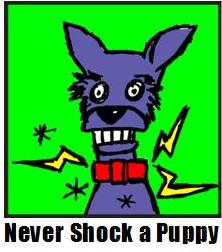 This post is part of the Never Shock a Puppy Campaign. Please click on the bright green and blue image to visit the Never Shock A Puppy blog and leave a commentbefore midnight MDT, Sunday, October 3. You’ll be entered into a contest to win great prizes including a gift certificate from K9Cuisine and a free training session with a reward-based trainer in your area!
This post is part of the Never Shock a Puppy Campaign. Please click on the bright green and blue image to visit the Never Shock A Puppy blog and leave a commentbefore midnight MDT, Sunday, October 3. You’ll be entered into a contest to win great prizes including a gift certificate from K9Cuisine and a free training session with a reward-based trainer in your area!
Tags: 13 tips for training a great recall, Carrot and stick, Clicker, Clicker training, E collar, Electric shock collar, Gigi Moss, Nana Will, Negative punishment, Negative reinforcement, Never shock a puppy, Patricia McConnell, Positive punisment, Positive reinforcement, Really great recall, Recall, Relationship with your dog, Reward Based Dog Training, Shock collar, Trish McMillan Loehr
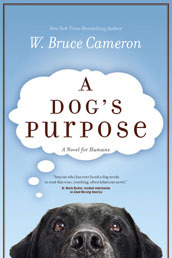 happens to the dog. The End.
happens to the dog. The End.